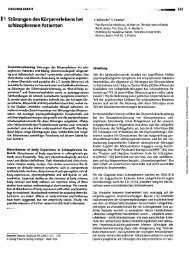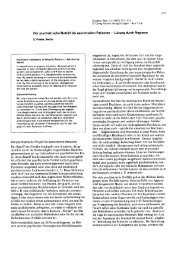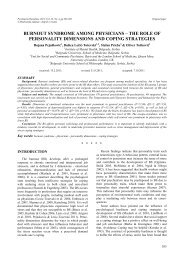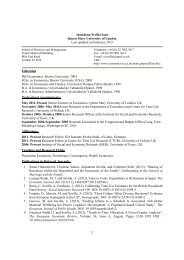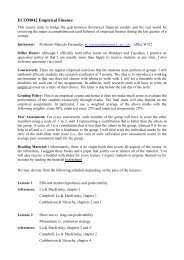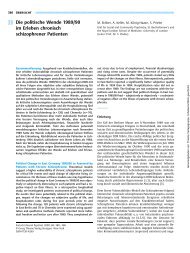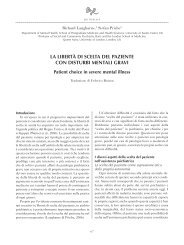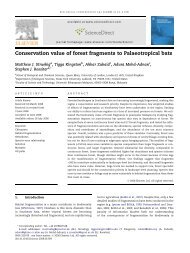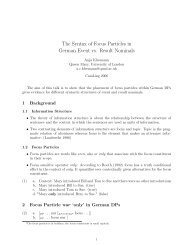Proofs - Personal Webspace for QMUL - Queen Mary, University of ...
Proofs - Personal Webspace for QMUL - Queen Mary, University of ...
Proofs - Personal Webspace for QMUL - Queen Mary, University of ...
You also want an ePaper? Increase the reach of your titles
YUMPU automatically turns print PDFs into web optimized ePapers that Google loves.
S48 F. Napo et al. / European Psychiatry 27 (2012) / supplement n°2 / S44-S49<br />
isolation, stigmatisation and social exclusion <strong>of</strong> psychiatric<br />
patients. In fact, social isolation may further augment mental<br />
disorders: Makanjoula and Olaifa (1987) reported in their study<br />
on negative mood states among Nigerians that “depression in<br />
particular, may be then considered both as a reaction to the loss<br />
<strong>of</strong> the position <strong>of</strong> the subject in the group to which the person<br />
belongs and as a reaction to the threat <strong>of</strong> a catastrophe” [27].<br />
Pr<strong>of</strong>. Baba Koumaré, the head <strong>of</strong> the department, explained<br />
that the existence <strong>of</strong> beliefs in external evil agents enables<br />
patients e.g. suffering from major depression to externalize<br />
their feelings <strong>of</strong> guilt and shame and thus to blame evil outside<br />
agents <strong>for</strong> their suffering, which then may be misdiagnosed by<br />
psychiatrists as paranoia or a psychotic rather than an affective<br />
disorder. On the other hand, a salutogenetic perspective<br />
emphasizes mechanisms that facilitate “resistance to psychotic<br />
symptoms”: external agents can evoke “self resistance” and<br />
power <strong>of</strong> the patient. It appears that the attribution <strong>of</strong> misery and<br />
pain to external agents also mobilizes group and family support.<br />
Explanatory models and concepts that are supported by a common<br />
belief may thus facilitate that the patient and accompanying<br />
family work together against the perceived threat.<br />
The interviewed experts also suggested that the apparent<br />
resistance <strong>of</strong> their patients against a perceived “external source<br />
causing illness” can reduce suicidal tendencies. A common<br />
enemy which <strong>of</strong>ten appears in the role <strong>of</strong> an “outsider” to the<br />
family clan may thus strengthen or reunite the family bond.<br />
The Malian experts emphasized that pr<strong>of</strong>essionals should not<br />
deny the cultural influence on illness concepts and rather<br />
integrate traditional and local explanatory models <strong>of</strong> suffering<br />
as an important resource <strong>for</strong> the therapeutic treatment <strong>for</strong><br />
the patients. This includes respect <strong>for</strong> traditional ways to heal<br />
mental illness, which were explicitely named by all patients as<br />
a necessary step <strong>for</strong> recovery.<br />
Altogether, our study underlines the importance <strong>of</strong> a culturally<br />
sensitive diagnostic process and <strong>of</strong> strengthening family<br />
bonds and social inclusion. Regularly involving relatives in a<br />
communal psychiatric setting <strong>of</strong>fers an important perspective<br />
<strong>of</strong> integrating and trans<strong>for</strong>ming the subjective conceptions <strong>of</strong><br />
patients suffering from psychotic symptoms. This African treatment<br />
perspective includes systematic approaches as well as<br />
transculturally relevant aspects and focuses on the resilience<br />
<strong>of</strong> patients and their families within a practical, salutogenetic<br />
approach.<br />
Confl ict <strong>of</strong> interest statement<br />
None.<br />
References<br />
[1] Antonovsky A. Gesundheits<strong>for</strong>schung versus Krankheits<strong>for</strong>schung. In A.<br />
Franke & M. Broda (Editors), Psychosomatische Gesundheit. Versuch einer<br />
Abkehr von Pathogenese- Konzept Tübingen: DGVT- Verlag, 1993;3- 14<br />
[2] Bleuler E. Dementia praecox oder die Gruppe der Schizophrenien. Berlin:<br />
Springer; 1911<br />
[3] Blumhagen D. On the nature <strong>of</strong> explanatory models. In Reidel R.(Editors)<br />
Culture, Medecine and Psychiatry Dordrecht,Holland, and Boston,U.S.A:R<br />
Publishing, 1981;5. 337- 37.<br />
[4] Bhui K, Bhugra D. Explanatory models <strong>for</strong> mental distress:implications<br />
<strong>for</strong> clinical practice and research. Brit J Psychiatry 2002;181:6- 7.<br />
[5] Callan A, Littlewood R. Patient satisfaction: ethnic origin or explanatory<br />
model? International Journal <strong>of</strong> Social Psychiatry 1998:44.<br />
[6] Carothers JC. Frontal lobe function and the African. J MentSci<br />
1951;97:122- 48.<br />
[7] Cochrane R, Bal S. Mental hospital admission <strong>of</strong> 1971 and 1981. Soc<br />
Psychiatry 1989;24:2- 11.<br />
[8] Cristeiner S. Frauen im Spannungsfeld zwischen Gesundheit und<br />
Krankheit. Bielefeld: Kleine Verlag, 1999;330- 452.<br />
[9] David M, Borde T & Kentenich H. Warum bin ich krank? Subjektive<br />
Krankheitsursachen- Vorstellungen türkischstämmiger und deutscher<br />
Patienten im Vergleich. In M. v. Dankwart, G. Hertel & S. Büring (Editors),<br />
Störungsspezifische Konzepte und Behandlung in der Psychosomatik<br />
Frankfurt: VAS- Verlag für Akademische Schriften, 2002;74- 80.<br />
[10] Dolo M. Problématique du système d’accompagnement des malades<br />
mentaux dans le service der psychiatrie de l`hôpital du point. Thèse<br />
2007;1:120.<br />
[11] Okello ES Musisi S. Depression as a clan illness (eByekika):an indigenous<br />
model <strong>of</strong> psychotic depression among the Baganda <strong>of</strong> Uganda. World J<br />
P 2006;60- 73.<br />
[12] Haasen C, Kleinemeier E, Yagdiran O. Kulturelle Aspekte bei der<br />
Diagnostik psychischer Störungen. In Assion H J (Hrsg.), Migration und<br />
seelische Gesundheit. Kulturelle Aspekte bei der Diagnostik psychischer<br />
Störungen. Berlin: Springer Verlag, 2004;45- 153.<br />
[13] Hardon A, Hodgkin C, Fresle D. How to investigate the use <strong>of</strong> medicines<br />
by consumers.World Health Organization and <strong>University</strong> <strong>of</strong> Amsterdam<br />
2004;1- 69.<br />
[14] Hardon et al. Analysis <strong>of</strong> qualitative data.in. Applied health research<br />
manual: Antropology <strong>of</strong> health care. Amsterdam, Het Spinhuis. 2001<br />
[15] Heinz A. Colonial practices in the construction <strong>of</strong> the schizophrenic<br />
patient as primitive man. Critique <strong>of</strong> Anthropology, 1998;18:421- 44.<br />
[16] Heinz A. Die Konzeptionen des „Selbst“ im kulturellen Vergleich.<br />
In Wohlfahrt E, Zaumseil M. (Editors), Transkulturelle Psychiatrie-<br />
Interkulturelle Psychotherapi.e. Interdisziplinäre Theorie und Praxis.<br />
Berlin: Springer Verlag, 2006;387- 90.<br />
[17] Inem VA, Ayankogbe OO, Obazee EM, Ladipo MMA, Udonwa NE, Odusote<br />
K. Conceptual and contextual paradigm <strong>of</strong> the family as a unit <strong>of</strong> care.<br />
Nig Med Pract 2004;45(1):9- 12.<br />
[18] Kahraman B. Die kultursensible Therapiebeziehung: Störungen<br />
und Lösungsansätze am Beispiel türkischer Klienten. Gießen:<br />
Psychosozialverlag, 2000;45- 6.<br />
[19] Kleinman A, Eisenberg L, Good B. Culture, illness, and care: clinical lessons<br />
from anthropological and cross- cultural research. Ann Intern Med<br />
1978;88:251–88.<br />
[20] Kleinman A. Rethinking Psychiatry: from Cultural Category to <strong>Personal</strong><br />
Experience. New York: Free Press, 1988:256.<br />
[21] Kleinman A. Patient and healers in the context <strong>of</strong> culture.An Exploration<br />
<strong>of</strong> the borderland between Anthropology, Medicine, and Psychiatry.<br />
Berkeley, Los Angeles, London: <strong>University</strong> <strong>of</strong> Cali<strong>for</strong>nia press; 1980.<br />
[22] Kora K, Özek M, Baral I. Ein Beitrag zum Thema der wahnhaften<br />
Depressionen (mit Fallbeispielen aus der Türkei ). In Koch E, Özek M,<br />
Pfeiffer WM, Schepker R. Chancen und Risiken von Migration- Deutschtürkische<br />
Perspektiven. Freiburg: Lambertus; 1998.<br />
[23] Koumare B, Coudray J P& Miguel- Garcia E. Der psychiatrische Dienst in<br />
Mali. Überlegungen zur Unterbringung von chronischen psychiatrischen<br />
Patienten bei traditionellen Heilkundigen. Curare 1989;12:145- 52.<br />
[24] Lambo A. The role <strong>of</strong> cultural factors in paranoid psychoses among the<br />
Yoruba tribe. The Journal <strong>of</strong> Mental Science 1955;101: 239- 66.<br />
[25] Leventhal H, Nerenz D R & Steele D J. Illness representation and coping<br />
with health threats. In A. Baum, S.E. Taylor & J. E. Singer (Editors),<br />
Handbook <strong>of</strong> Psychology and Health Volume IV: Social Psychological<br />
Aspects <strong>of</strong> Health New Jersey: Erlbaum; 1984;219- 252.<br />
[26] Linden M. Krankheitskonzepte von Patienten. Psychiat Prax 1985;12:8- 12.<br />
[27] Livingstone FB, Dobzhansky T. On the non-existence <strong>of</strong> human races.<br />
Curr. Anthropol 1962;3(3):279-81.<br />
[28] Makanjjoula JDA, Olaifa EA Masked depression in Nigerians treated at<br />
the Neuro- Psychiatric Hospital Aro, Abeokuta. Acta Psychiatr scand<br />
1987;76:480- 5.<br />
[29] Mayring P. Qualitative Inhaltsanalyse [28 Absätze]. Forum Qualitative<br />
Sozial<strong>for</strong>schung / Forum: Qualitative Social Research [On- line<br />
Journal],1(2). Available from: http://qualitative- research.net/fqs/fqsd/2-<br />
00inhalt- d.htm, 2000, Juni. [11.05:2011].<br />
[30] Murphy HBM. The advent <strong>of</strong> guilt feelings as a common depressive<br />
symptom: a historical comparison on two continents. Psychiatry<br />
1987;42:229- 49.<br />
<strong>Pro<strong>of</strong>s</strong><br />
08_Napo.indd S48 14/06/2012 14:44:50





